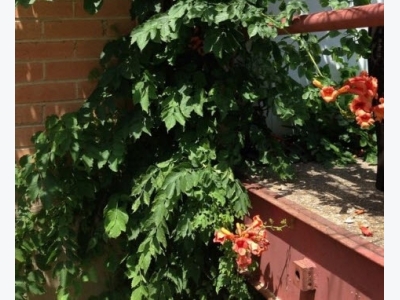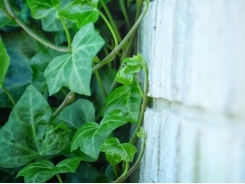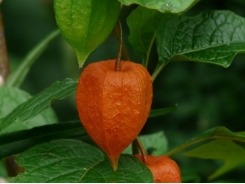How to Grow Trumpet Vine

Gardening expert, Michael Dirr has commented that if you can’t grow trumpet vine (Campsis radicans), you might as well give up gardening.
Indeed, in the right conditions, this fast-growing vine is a cinch to grow. In mild, moist climates, the vine can become downright aggressive. It grows quickly to 30 feet tall or more, and attaches itself with aerial rootlets to almost any surface.
If you can temper its aggressive nature, trumpet vine (also called trumpet creeper) makes a showy, extravagant landscaping vine. Grow it on a strong structure, such as a fence or arbor, and give it at least 8 to 10 feet to stretch out. It has dark green leaves that are alternately palmate. The vine produces trumpet-shaped flowers in coral, yellow, red or orange, from mid-to-late summer. The bright blooms act as a magnet for hummingbirds.
Planting Trumpet Vine
Trumpet vine thrives in USDA plant hardiness zones 5 through 9. Plant potted nursery plants in spring, after the last frost. You can also sow seeds in the fall and store the pots in a cold frame. Take cuttings in winter for spring planting.
In hot climates, trumpet vine tolerates partial shade, but it blooms best in full sun. Native to the southeastern United States, trumpet vine tolerates almost any soil type, so long as it drains well. Soils that have moderate to poor fertility seem to work better than rich, fertile ones.
Fertilize trumpet vine in the spring with a ¼ cup of 10-10-10 fertilizer. Water it frequently immediately after planting. Established plants prefer consistently moist conditions, but they’ll tolerate some drought. If you live in a warm, moist climate, cut back further on watering, which can help prevent invasiveness.
Trumpet vine spreads through underground runners, as well as seed. Mulch the soil, which can help prevent some self-sowing, and pull up any volunteers that appear. Remove the seed pods and destroy them. Trumpet vine produces blooms on new wood, so you can prune it in spring without fear of destroying the flowers. Prune it back hard, especially in warm climates. Trumpet vines can take five to six years to become established and bloom well, but once they get going, watch out!
Trumpet Vine Pests and Disease
The trumpet vine's hardy nature means it can fight off most insect pests and diseases. The most common diseases include powdery mildew and leaf spot. In most cases, you can ignore these problems. Planting trumpet vine in full sun, with adequate space so air circulates freely, can prevent most fungal diseases. Remove any diseased plant material and treat with a fungicide if the problem becomes severe.
Trumpet vines are sometimes bothered by leaf-sucking insects, such as leafhoppers, whiteflies and aphids. Dislodge them with a steady stream of water or apply an insecticidal soap or oil to the leaves. In most cases, the insect pests move on before the damage is sufficient enough to warrant chemical treatments.
Trumpet Vine Varieties
Campsis radicans ‘Apricot’ is a very common variety that grows to 15 feet tall. It produces 4 inch long blooms in apricot hues.
Campsis x tagliabuana 'Madame Galen' is an old hybrid between Campsis radicans, the American native, and Campsis grandiflora, which is native to China. The resulting plant grows 15 feet tall and produces lovely salmon-colored blooms. ‘Madame Galen’ is less invasive than Campsis radicans varieties.
Campsis radicans ‘Indian Summer’ is hardier than most trumpet vines, growing in USDA zones 4 through 9. This woody vine produces yellowish-orange blooms that have red throats.
Related news
Tools

Phối trộn thức ăn chăn nuôi

Pha dung dịch thủy canh

Định mức cho tôm ăn

Phối trộn phân bón NPK

Xác định tỷ lệ tôm sống

Chuyển đổi đơn vị phân bón

Xác định công suất sục khí

Chuyển đổi đơn vị tôm

Tính diện tích nhà kính

Tính thể tích ao



 Garden tips: What to do in your garden…
Garden tips: What to do in your garden…  How To Grow Chinese Lantern Flower (Physalis alkekengi)
How To Grow Chinese Lantern Flower (Physalis alkekengi)